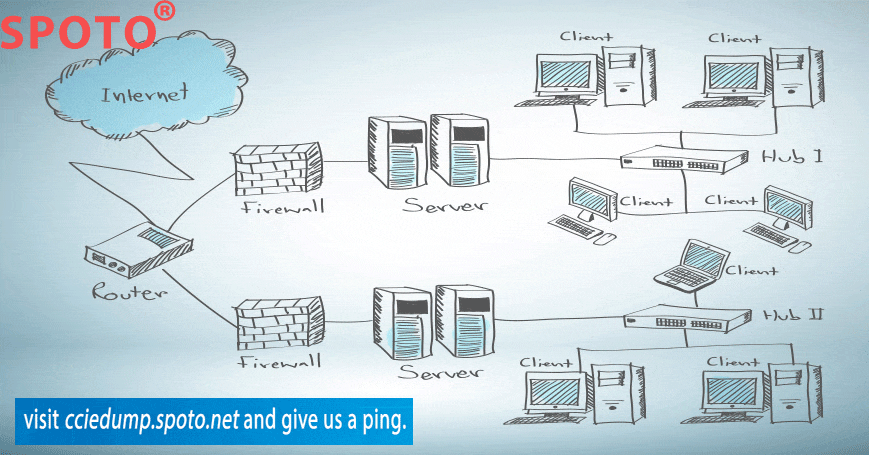SPOTO focus on IT certification training for 16 years. Over 16 years, SPOTO helped tens of thousands of candidates achieve their Cisco CCNA, CCNP, CCIE, CISSP certification. Subscribe us and get more news. I have known something about the two kinds of network topology. Now, I will introduce its useful knowledge.
Network topology design is divided into single core and dual core.
First, Single core network topology design.

(The above picture shows that the router is connected to the external network, and can also connect to other branches of the company. For example, it is now a branch in Shanghai. It can also be connected to the Beijing branch by a router. Of course, it must rely on the backbone network of China Unicom or Telecom. )
A single core network means that there is only one core switch in the entire network environment. This topology is suitable for enterprises with small network size and low network dependence. Because the price of core devices is very expensive, such as Cisco devices, most companies use a single-core network topology design. However, this design has a fatal flaw that can easily cause a single point of failure. When the engineers realized the problem, the second topology was created.
Second, Dual-core topology

The so-called dual-core means that there are two core switches in the entire network environment. This environment is characterized by good stability, high transmission, and high transmission rate. The core switch is the central node of the entire network, so the requirements for the core switch are very high. At the same time, two core switches are equipped as the core switching nodes of the entire network, which completely avoids the impact of a single point of failure on the entire network, thereby improving the security and stability of the network. Because the core switch costs are relatively high, the investment and maintenance costs of the two core switches are also high, so generally, only telecommunications, financial and other enterprises adopt this dual-core topology design structure.
Whether it is a single core or dual core topology, there are 3 points to note
1. If there is a server in the network environment, the server should be connected to the aggregation layer switch, and sometimes the server can be connected to the core layer switch.
2. Because the core layer is responsible for the high-speed exchange of data, some routing strategies are generally configured at the aggregation layer.
3. The core layer, the aggregation layer, and the access layer are standard three-layer structures. If the enterprise network size is not large, the aggregation layer can be omitted and become the core layer and the access layer.
Next, let's talk about the export design of the network, which is how to connect to the external network.
There are three common ones now.
1, using a proxy server, often used in small and medium-sized network environments
2, using a router to connect to the external network, the router provides a variety of interface types, can also connect to different networks, also supports a lot of communication protocols, suitable for large and medium-sized enterprises. It is currently the most widely used. According to the access to the external network is to connect an ISP or connect two ISPs into a single-outlet design and dual-outlet design.
One. Single exit design
If the enterprise network does not require the Internet to be too high, the single-outlet design can be adopted, and then the routing policy is configured on the access device.
1. Proxy server access plan
Proxy server access is software-based, it requires a well-configured desktop. This type of program has less investment and is suitable for small businesses.

2, router access plan
There are many types of interfaces supported by the router. Users can access the Internet through multiple methods. The router also supports multiple protocols and is suitable for different network environments, and is generally used in medium-sized enterprises. As shown below.

two. Double outlet design
If the user has high requirements on the network, you can use a dual-exit design, that is, access the INTERNET with dual links.
1. The proxy server access scheme uses two proxy servers, which are respectively connected to different operators, such as one server connected to Unicom and one server connected to telecommunications. As shown below.

2. The router access scheme uses two routers to connect to different operators. The router needs to add modules. as the picture shows

In summary, these are common in basic network topologies. It may be simple for some masters, but it is still very useful for novices~

 Join Telegram Study Group ▷
Join Telegram Study Group ▷














